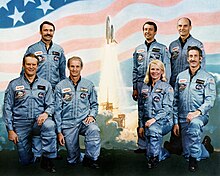
Back STS-51-D Arabic STS-51D Bulgarian STS-51-D Czech STS-51-D Danish STS-51-D German STS-51-D Spanish STS-51-D Estonian استیاس-۵۱-دی Persian STS-51-D French STS-51-D Galician
 | |
| Names | Space Transportation System-16 |
|---|---|
| Mission type | Communications satellite deployment |
| Operator | NASA |
| COSPAR ID | 1985-028A |
| SATCAT no. | 15641 |
| Mission duration | 6 days, 23 hours, 55 minutes, 23 seconds |
| Distance travelled | 4,650,658 km (2,889,785 mi) |
| Orbits completed | 110 |
| Spacecraft properties | |
| Spacecraft | Space Shuttle Discovery |
| Launch mass | 113,802 kg (250,890 lb) |
| Landing mass | 89,818 kg (198,015 lb) |
| Payload mass | 13,039 kg (28,746 lb) |
| Crew | |
| Crew size | 7 |
| Members | |
| EVAs | 1 |
| EVA duration | 3 hours, 6 minutes |
| Start of mission | |
| Launch date | April 12, 1985, 13:59:05 UTC (8:59:05 am EST) |
| Launch site | Kennedy, LC-39A |
| Contractor | Rockwell International |
| End of mission | |
| Landing date | April 19, 1985, 13:54:28 UTC (8:54:28 am EST) |
| Landing site | Kennedy, SLF Runway 33 |
| Orbital parameters | |
| Reference system | Geocentric orbit[1] |
| Regime | Low Earth orbit |
| Perigee altitude | 300 km (190 mi) |
| Apogee altitude | 452 km (281 mi) |
| Inclination | 28.45° |
| Period | 94.40 minutes |
| Instruments | |
| |
 STS 51-D mission patch  Back row: Griggs, Walker and Garn Front row: Bobko, Williams, Seddon and Hoffman | |
STS-51-D was the 16th flight of NASA's Space Shuttle program, and the fourth flight of Space Shuttle Discovery.[2] The launch of STS-51-D from Kennedy Space Center (KSC), Florida, on April 12, 1985, was delayed by 55 minutes, after a boat strayed into the restricted Solid Rocket Booster (SRB) recovery zone. STS-51-D was the third shuttle mission to be extended.
On April 19, 1985, after a week-long flight, Discovery conducted the fifth shuttle landing at KSC. The shuttle suffered extensive brake damage and a ruptured tire during landing. This forced shuttle landings to be done at Edwards Air Force Base, California for the next five years until the development and implementation of nose wheel steering made landings at KSC more feasible.
- ^ "SATCAT". Jonathan's Space Report. Retrieved March 24, 2014.
- ^ "STS-51D Press Kit" (PDF). NASA. Retrieved December 16, 2009.
 This article incorporates text from this source, which is in the public domain.
This article incorporates text from this source, which is in the public domain.